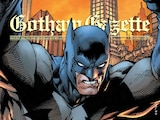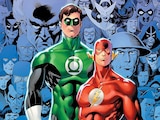It’s a great time for Superman fans, with the Man of Steel soaring into movies, TV, animation and comics. To help us stay on top of it, we're sharing what's grabbed our attention and why in this monthly Superman column. In today's installment, guest writer Jules Chin Greene bids a heartfelt goodbye to Action Comics writer Phillip Kennedy Johnson.
Writer Phillip Kennedy Johnson has been at the center of Superman and his family’s story for the last few years at DC Comics. Together with artists like Daniel Sampere, Riccardo Federici, Rafa Sandoval and Mike Perkins, Johnson’s Action Comics established a new status quo for Superman. Sadly, this month, Johnson’s seminal run on this perennial title will come to a close with the soon-to-release Action Comics 2023 Annual #1. Johnson’s contributions to the Superman Family have been immense, so let’s take the opportunity to look back and acknowledge some of them.
Phillip Kennedy Johnson’s approach to Superman revolves around an idea of heritage—an idea that’s specific to the Man of Steel. The tone of Johnson’s run has the same feel as an old family or cultural tale. It’s an apt choice, because at this point in time, most Superman fans were born well after Action Comics #1. In that regard, Superman’s adventures in Action are an heirloom from a larger cultural tapestry. He is a figure whose ideals are passed down from generation to generation, his mythology always evergreen. Johnson’s thematic focus on heritage and legacy has brought Action Comics full circle, and it will undoubtedly change how writers approach this flagship title in the future.

Of course, the bulk of Johnson’s time on Action was devoted to the Warworld Saga storyline, where Superman and his Authority team ventured to the gladiatorial planet to bring down its tyrannical ruler, Mongul. I’m going to be frank, and I’m going to put it simply: the Warworld Saga was the most imaginative Superman story since Grant Morrison and Frank Quitely’s All-Star Superman. (It’s no coincidence that Morrison helped to kick it off with their four-issue Superman and the Authority miniseries.)
Since Warworld is situated under the rays of a red sun, nullifying Superman’s powers, the Man of Steel was forced to become a fierce but compassionate warrior in the vein of sword and sandal epics like Spartacus. But beyond the epic gladiatorial battles of the Warworld Saga, the story explored the myriad of alien cultures on the planet, many of whom were brought there unwillingly.
This is what made the Warworld Saga sing, as it dug into the human truths at the center of Superman’s story. Warworld, with its stranded alien cast, takes the book’s examination of heritage beyond a surface level understanding of Superman within pop culture. Instead, it places him inside a larger ecosystem of loss and violence within the universe. In doing so, it establishes the universality of Superman’s story and condition beyond the farthest reaches of the DC Universe.

Superman writers have long emphasized that he is a refugee, and Johnson’s writing expanded this further by fleshing out the concept of a Kryptonian diaspora. On Warworld, Clark met two young children, Osul-Ra and Otho-Ra, who are of Phaelosian descent. The Phaelosians are originally from Krypton but left the planet long before its demise. By becoming a father figure to the two orphans, Superman is given the opportunity to nurture a Kryptonian childhood he never had. And with Osul-Ra and Otho-Ra now the adopted children of Clark and Lois, there is so much left to be explored about what it means to be Kryptonian when Krypton itself no longer exists. Superman is a powerful metaphor for cultural continuity in the wake of disaster, and the Super-Twins are the next chapter in this story.
Johnson’s run also made the case for why Superman’s rogues rank among DC’s best. He transformed and revitalized a different Superman villain with every arc. Whether it was exposing the genocidal actions of Mongul, turning Cyborg Superman into a body horror Knight Terror, or imbuing Metallo with a tortured soul, Johnson approached each villain with a clear understanding of their place within the Superman mythos. Metallo in particular is worth calling out.

Without ever being heavy-handed, Johnson reimagined John Corben as an anguished consequence of war and domestic violence, making the villain just as compelling as Superman himself. In Action Comics #1056, Cyborg Superman taunts Metallo by saying, “You’ve only ever been a tool, wielded by your betters. A sad, discarded little gun…that dreamt it was a man.”
The moment is one of many in Johnson’s run where he cuts to the heart of the human cruelty we see both in our world and in Metropolis, further exemplifying why Superman’s ideals are so necessary. Johnson’s Metallo is a deeply empathetic and compassionate take on the villain, and is one of Metallo’s best stories to date.
Phillip Kennedy Johnson’s Action Comics has been led with soul and purpose. It’s introduced new characters like the Super-Twins alongside complicated figures like Kryl-Ux, while expanding Kryptonian history. It’s shown fans the world over how malleable the Man of Steel can be across a variety of genres. Regardless of what the next chapter of Action Comics will bring for Superman, Phillip Kennedy Johnson’s run will be long remembered for its compelling and thought-provoking take on the Man of Tomorrow.
Look for Action Comics 2023 Annual #1 by Phillip Kennedy Johnson, Max Raynor and Matt Herms in stores on December 26th!
Jules Chin Greene writes about comics for DC.com, and his work can also be found at Nerdist, Popverse and Multiverse of Color. You can follow him on Twitter and Bluesky at @JulesChinGreene.
NOTE: The views and opinions expressed in this feature are solely those of Jules Chin Greene and do not necessarily reflect those of DC Entertainment or Warner Bros., nor should they be read as confirmation or denial of future DC plans.















